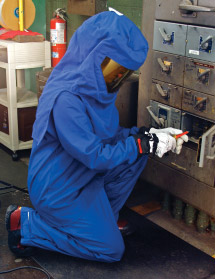Arc Flash Safety

Protecting electrical workers since 1958, Lineman's Testing Laboratories is your single source for arc flash safety. Our complete Arc Flash Safety Program includes a CSA Z462-compliant Arc Flash Hazard Study, labeling of all applicable electrical equipment, supply of required personal protective equipment (PPE), and training.
Proper safety practices and on-going personnel training can minimize the likelihood of electrical injuries and fatalities due to shock, electrocution, arc flash and arc blast. At risk are employees who work on or near exposed energized electrical conductors or circuit parts including electrical maintenance personnel, operators, troubleshooters, electricians, linemen, engineers, site safety personnel, or anyone exposed to energized equipment of 50 volts or more.
It's the physical effect of an electric current that enters the body, ranging from a minor static-electricity discharge to a power-line accident, lightning strike or industrial apparatus contact. The effects depend on the current (not the voltage), and the worst damage occurs along its path from point of entry to exit. Causes of immediate death are ventricular fibrillation and paralysis of the brain's breathing centre, or of the heart.
What is an Arc Flash?It's a dangerous release of energy created by an electrical fault. Such a release will contain thermal energy, acoustical energy, pressure wave and debris. Heat builds to 19,426°C; copper vapor expands by 67,000 times; and there is molten metal, intense light, hot air rapid expansion, pressure waves, sound waves and shrapnel.
What is an Arc Blast?It consists of pressure, sound and shrapnel: pressure can easily exceed hundreds or even thousands of pounds per square foot; sounds of 160 decibels occur; and shrapnel can exceed 700 miles per hour.
What causes an Arc Flash?Electricity travels the path of least resistance. When the path of electricity is suddenly interrupted, a new pathway is created. The arc can be generated by mechanical failure, current overload, accidental contact, or human error.












































































































